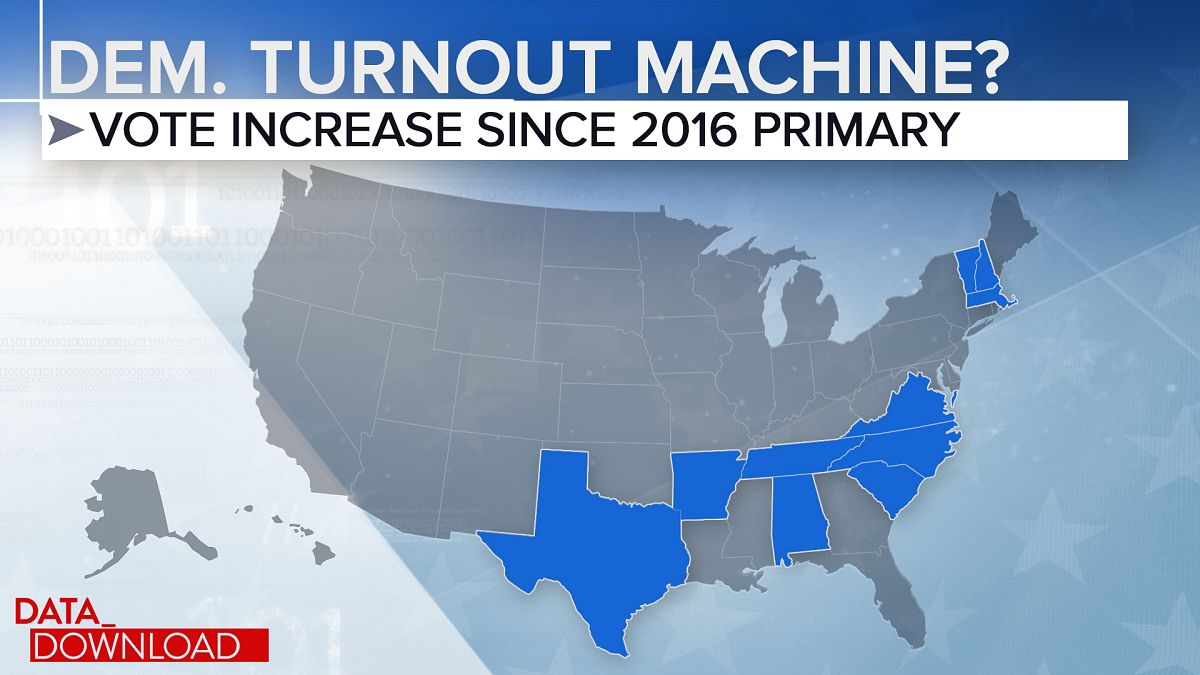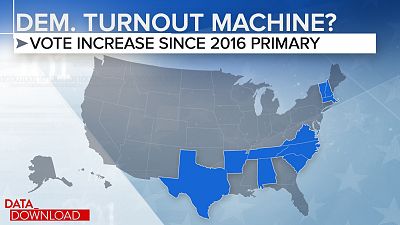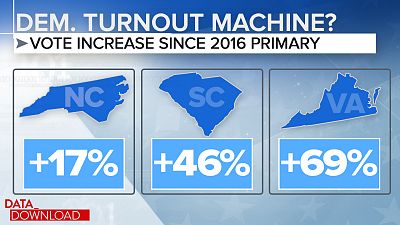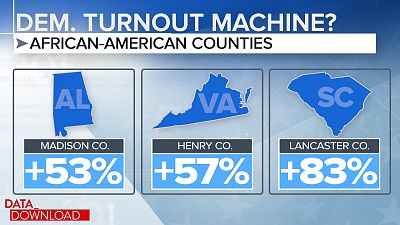Results from Super Tuesday show that Joe Biden can tap into a strong wave of support from Democrats.
WASHINGTON - Vermont Sen. Bernie Sanders' 2020 run for the White House has been predicated on his ability to energize the electorate and bring new voters to the polls. But results from primary statesso far suggest that increases in the vote up to now have not helped Sanders.In fact, the bumps may be aiding former Vice President Joe Biden and showing his strength with a particularly important group of voters, suburbanites.There have been 12 Democratic primariesso far in this cycle in states that also held primaries 2016. And in 10 of those states, there were more votes cast in 2020: Alabama, Arkansas, Massachusetts, New Hampshire, North Carolina, South Carolina, Tennessee, Texas, Vermont and Virginia. (California's vote numbers are not yet final, but they may end up slightly down from 2016.)
There is some evidence in those numbers for drawing in new voters. But eight of those 10 states went to Joe Biden and six of them went for Biden by double-digits. And remember that is in a year that, up to last week, had a big field of candidates dividing up the vote.Sanders did win two of the states with higher vote production. But one was his home state of Vermont, which he won by a landslide, as one would expect. The other was Vermont, where Sanders eked out a narrow 1.3 percentage point win.If the Democratic nominating process has been drawing new voters to the polls, why has that favored Biden? The most-cited answer has been African American voters. They were seen as his South Carolina firewall and on Primary Day, they turned out there and in other states. Some of the county-level numbers showed the difference.
In Lancaster County South Carolina, where the population is 22 percent African-American, the number of votes was up 83 percent compared to 2016. And in the county, Biden got 980 more votes in 2020 than Hillary Clinton received in 2016. Sanders got a bump too, compared to his 2016 tally, but it was smaller, only about 470 votes.You could see the same pattern in places such as Henry County Virginia and Madison County Alabama (the home of Huntsville). In those counties, each more than 22 percent African American, the vote was up 57 percent and 53 percent respectively. And in both cases, Biden's votes outpaced Hillary Clinton by a much bigger margin than Sanders did compared to his 2016 numbers.In fact, across the south, counties with larger African American populations generally produced more votes this year than they did in 2016, but it didn't help Sanders. Even in the places where he did slightly better, he usually wound up with a smaller percentage of the vote than he won in 2016. In effect, the increased turnout in those counties hurt him.But the other, and bigger, factor in Democrats primary turnout surge appears to be coming from urban/suburban voters around major metro areas. There are a lot of votes available in those communities, many of them have turned out in bigger numbers so far in 2020 and they have turned out for Biden.
In South Carolina, Charleston County turned out 23,000 more votes than it did in 2016. Biden got 1,600 more votes than Hillary Clinton got in 2016, while Sanders won 1,200 fewer votes than he did in 2016.In suburban Washington DC, Fairfax and Loudoun counties in Virginia turned out 104,000 and 35,000 more votes respectively. In Fairfax, Biden pulled 33,700 more votes than Clinton did in 2016. In Loudoun he got 15,000 more. Sanders, meanwhile, did better in those two counties than he did in 2016, but not by nearly as much, improving by 6,500 and 3,300 votes respectively.And in Greater Charlotte N.C., Mecklenburg County produced 42,000 more votes than it did in 2016. Biden got 727 more votes out of that county than Clinton got in 2016. Sanders, meanwhile, got 6,300 fewer votes.Those are big moves.It's hard to pinpoint exactly what's driving those surges and the movement to Biden. The 2020 landscape is different than 2016 in a lot of ways.It may be that some of Sanders 2016 success was about Hillary Clinton and her absence in the 2020 field has brought out different voters wanting to make their voices heard.And, of course, there's Donald Trump, who seems to drive all of the nation's political discussion and action these days. His struggles with suburban voters are well-known and a big part of the Democratic Party's big wins in 2018. It may be that his presidency has pushed more suburban voters to come to the polls to cast their vote in the Democratic nominating contests - and cast them for Joe Biden, at least for now.Remember, none of these primaries was closed. That means independents and in some states Republicans probably voted in the Democratic primary, particularly since there is no GOP presidential primary this year.Next up on the Democratic primary calendar on Tuesday: states such as Michigan, Mississippi, Missouri and Washington. Those are states with large suburban populations, large African American populations, or both, and they are all states with primaries that are open to all voters.Considering recent results, that could be a bad set of factors for Bernie Sanders. Because the numbers so far suggest the Democratic Party may indeed be bringing some new voters to the polls, but they don't seem to be Sanders voters. And if the Democratic primary electorate keeps expanding in the same way, the Vermont senator could find himself in a difficult place come Wednesday morning.





